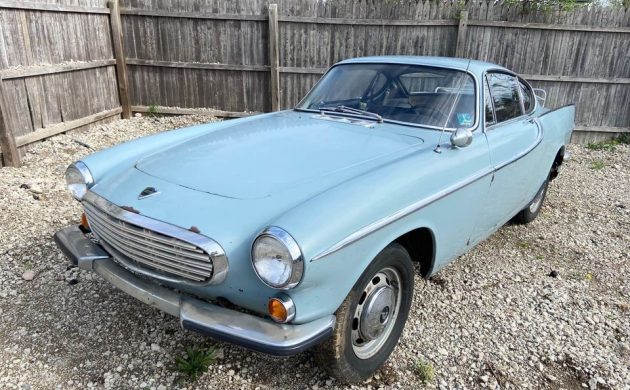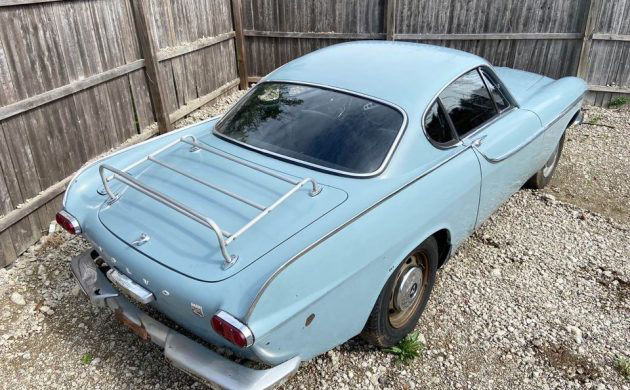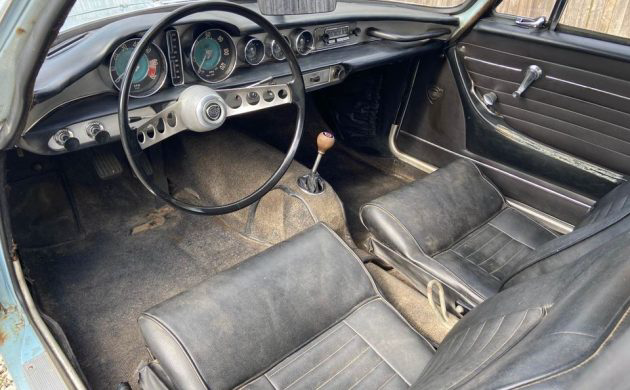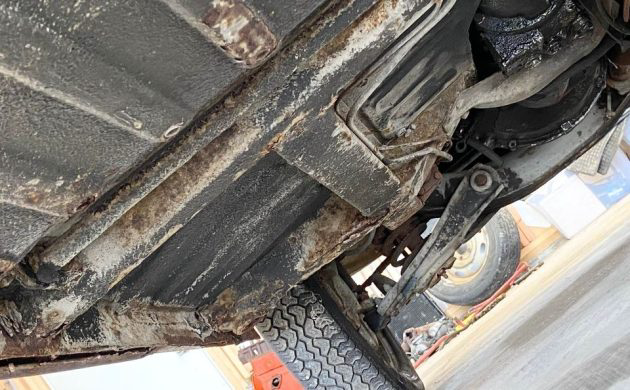In today’s economy, you have to stretch every dollar. As enthusiasts of classic vehicles, we know that costs are soaring daily. What if you could purchase a vehicle suitable for Cars and Coffee and the occasional Monday commute? What if you could find a vintage car that would last forever with proper maintenance and care? This 1966 Volvo P1800S for sale on Facebook Marketplace in Armada, Michigan may be the perfect vehicle to serve both at car shows and on your Monday morning commute in perpetuity. This sleek Volvo has been stored in an aircraft hangar since the early 1980s and boasts a scant 56,085 miles on the odometer. Be advised that this Volvo requires refurbishment before hitting the road once again. It is, however, pretty solid as far as P1800s go, and these cars have a proven track record of being boringly reliable and safe if properly maintained. Is the $6,900 asking price out of line here? Thanks to Ted for the tip!
Like all of you surely do, I daydream about cars a lot. That provides pretty good free entertainment because I sure don’t have the funds to make these dreams a reality. One of these recurring dreams centers around building up and enjoying a good example of Volvo’s quirky P1800. Imported cars from the fifties and sixties are an acquired taste for most American car lovers. Compared to the high horsepower overly styled chrome dreamboats that America was punching out, imported cars were smaller, usually had styling that reflected the tastes of their home market, and were almost impossible to get parts from. Nearly all of them had smaller engines with just four cylinders. Given the American market at the time, cheap gas prices and all, you could see why brands such as Renault, Peugeot, Opel, Saab, Volvo, Toyota, Datsun, and the rest struggled to force their seeds to find purchase in the lucrative but sometimes baffling American market.
One brand that gained slow but steady ground was Volvo. Starting with their rather antique-looking PV444 in 1956, Volvo soon gained a following for their reliable, well-built cars with excellent handling was a bonus. The brand slowly burnished its reputation by keeping the same layout but making gradual improvements as the production run of the PV444 and its successor the PV544 stretched out over the years. Meanwhile, uncharacteristic of Volvo’s staid reputation, the company was developing a sports car in an attempt to capture more of the American and European marketplaces. Work started in 1957 on the P1800 and culminated in the first P1800 leaving British body maker Jensen’s facility in September of 1960.
This quirky little car was marketed as a sporty 2+2, although you would have to search up a pair of Lilliputians to find individuals who could fit comfortably in the back seat. The car’s drivetrain was the standard Volvo B18 inline-four-cylinder engine with an impressively stout five main bearings. Belting out 100 horsepower and backed by, initially, a four-speed manual, the running gear was rock solid. From 1963 on, customers could have that four-speed manual, a four-speed manual with overdrive, or a three-speed automatic transmission. This aerodynamic car was naturally a long-legged driver’s car of the first order. Build quality also improved once body construction was moved from Jensen to Volvo’s plant in Gothenburg in 1963. The engine was also punched out to 2.0 liters of displacement and was able to produce 118 horsepower. The improvements brought about a slight name change to P1800S.
The 1966 Volvo P1800S you see in the pictures is a very original example that reveals the kind of car the company was producing at the time quality-wise. To get a better grasp of how well these cars were built, compare the condition of the interior above to that of any other original car of the era that we have featured here on Barn Finds. As you can see, Volvo’s use of robust components paid off. We all know of Irv Gordon’s 1966 P1800S with a remarkable 3,000,000+ miles on the odometer. While the durability of the drivetrain is without question, the rest of the car had to get to that number in one piece as well. The seller tells us that this car has just 56,085 miles on the odometer to put the potential of this particular P1800 in perspective.
We are told that the person the seller purchased the car from had owned it since 1973. While we would like to know more about the car’s history, the only other tidbit revealed is that it was stored in an aircraft hangar since the early 1980s. That storage was good for the car’s condition, as rust is a problem with P1800s of all vintages. Looking through the pictures reveals some sun bleaching, chipping, and fading of the paint, but no real body damage is visible save for some spots on the door sill that will need closer examination. A picture of the underside reveals surface rust and some questionable gaps around the aforementioned sills. The good news is that all of this can likely be fixed or patched satisfactorily without completely stripping down the body and trussing it up for repairs. The seller does cautiously remark that the car needs full restoration.
Perhaps that statement is made because the engine has been removed and disassembled. One has to wonder just what happened to a B20 engine at 56,085 miles to cause someone to do such a thing. A look at the picture below doesn’t reveal any alarming holes in the block or damaged parts. On the good side, the engine bay looks undamaged. That includes the battery shelf, which is often rusted out due to the corrosive nature of the liquid in the item that sits on it.
The seller also tells us that a link to over 250 photographs of the car can be forwarded upon request. That type of transparency is notable and should be the norm rather than the exception. Once the undercarriage and sills were examined closely, a prospective buyer would have a few options available to them. A full restoration would be more costly and time-consuming but would result in a car that could be used for decades if properly cared for. A more budget-friendly approach would be to fix what needs to be fixed, stop any rust, and get the car back on the road. In either case, a rebuild of the engine is prudent since it is out and disassembled anyway.
The beauty of any P1800 is its potential to be one of those last purchase items. You could live with a P1800 daily and be happy. You and I also have to admit that we likely don’t have 3,000,000 miles on the road ahead of us. An investment in this car would be a good one if you were going to ride it into the sunset. Small things can be fixed, but overall durability is a quality that few cars possess to the extent that a Volvo P1800S does.
What would you do with this P1800? Do you think it is the best example of a car to ride off into the sunset? If not, what car would you suggest for that role? Please share your thoughts in the comments.











Nice write up Jeff. Got enough time with these cars to say they are great driving cars. Mechanically they are tough and if you want more horse power it’s easy to get. 150 hp is available for street engines with minimal modifications and the one I raced for a while had 226 hp at the rear wheels.
As noted innumerable times on this site (by yours truly), the “P” designation on the Volvo 1800 was dropped by 1964. This car is an 1800S. Michelle knows.
Yep! When it picked up the “S”, it lost the “P”.
True, but non Volvo lovers wouldn’t know what an1800s was, but the do know what a P1800 is.
In high school, I had a145 in the same colour, my mate had a baby poo brown P1800, he was over 7feet tall, but fitted fine in the P.
We were know as the Volvo boys, lol.
The point is that a LeMans is not a GTO; every GTO is not a “Judge”;
every Impala is not an SS 396; etc etc.
The P1800 is an English-made/assembled Volvo, and the post-1963 cars are Swedish-made. There is a distinction, and as such, the values on these variations can be significant. For whatever reason, the fewer Jensen-made P1800 cars seem to cost more than the Swedish 1800S cars.
I am not trying to be pedantic, but, a classic car website should be aware of these distinctions, especially after I have been pedantic on this topic a hundred times.
Beet me to it!
No “P” was harmed in the manufacture of this car!
I always thought these are beautiful cars since the time I was a little kid . It looks like theres a lot to work with here. But you’d really have to know what your looking for to see if anything is missing. This looks very solid and I sure do hope it gets restored at the very least mechanically and put back on the road where it belongs. Even if it doesnt go 3 million miles.
yes, lubed the too (asa kid). Then some 1 dumped one on me w/transmission problems. “A favor”. The sun gear, electric involvement, was too much for me’n hada give it back. No harm, no foul (“free is as free duz”).
I’ve owned a couple of these back in the early 80s when they were affordable. Like mentioned above they are nice driving cars ment for comfortable cruising at even todays interstate speeds.At this price if you can do most of the mechanical work yourself, you could enjoy this for a long time. My guess is it will be redone and become unobtainium to a lot of us who remember Irv and these fondly.
I walked by one of these everyday for 4 years, red with a tarp half covering it on my walk to high school 86-90. I always dreamt even back then of dropping a big block in it and making it a poor man’s Cobra. Who knows maybe one day I’ll scratch that itch..glwta
Volvo discussed dropping the Ford 260 V-8 in a high-performance version of the 1800 series, à la Sunbeam Tiger. Apparently management though it would be bad for Volvo’s image to use somebody else’s motor, although it was certainly not an issue for Sunbeam, Jensen, Iso Rivolta, or every British Leyland car that used the GM aluminum V-8.
I wish they would have done it.
6900.00 is a steal. I’m surprised it’s still listed.
Totally agree, if it was here in Aus, it would be in my garage.
The reason the engine is lying in pieces on the garage floor is because it has done at least 158,000 miles. Check the wear under the accelerator pedal where the drivers heel has worn the carpet threadbare. Now look underneath at the rear of the gearbox and check how much residue oil is clinging to it. With a bit of effort it could still be a wonderful first timers restoration job, and if done right will outlast most of us! Great cars are the old Volvo’s and the current crop aren’t bad either.
…and not one mention of Roger Moore in “The Saint” and his Volvo co star..I hope or the best for this classy, sporty Swede.”How Swede it is!”..or will be again.m
I agree! Paint it white, and get your Simon Templar on!
I have a friend that had one of these, in this color, many years ago. This is a tall man’s car, without a doubt. A sweet ride.
I thought the speedometer had turned over at least once as well. Nothings cheap anymore but you could get this back on the road without much drama. The motor’s dead simple. Then you could decide what to do with it as you enjoy it. They’re starting to bring enough money to justify a full on restoration but then you wouldn’t have your car to enjoy for a year or two. It’s easy to make these cars quick (not fast, quick) and parts are more available than when they were new.
If there was any room at the inn, I’d be all over this…